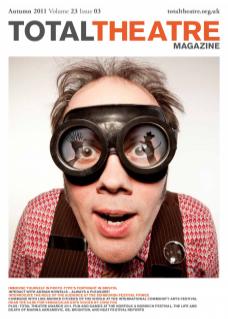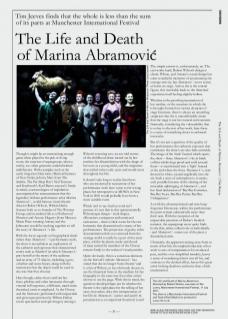Though it might be an entertaining enough game when played in the pub or living room, the creation of supergroups, when a reality, too often generates underwhelmed indifference. With examples such as the easily forgotten Electronic (Bernard Sumner of New Order, Johnny Marr from The Smiths, The Pet Shop Boy’s Neil Tennant and Kraftwerk’s Karl Bartos anyone?) firmly in mind, a certain degree of trepidation accompanied the announcement that the legendary Serbian performance artist Marina Abramović, world-famous visual theatre director Robert Wilson, Willem Dafoe (known both as co-founder of The Wooster Group, and in another life as a Hollywood filmstar) and Antony Hegarty (from Mercury Music Prize winning Antony and the Johnsons) would be working together to tell the story of Abramović’s life.
With the focus squarely on biographical detail rather than Abramović’s performance work, the show is nevertheless an exploration of the catharsis and exposure that characterised works such as Rhythm 0 (in which Abramović puts herself at the mercy of the audience and an array of 72 objects, including a gun, a feather and some honey, along with the instruction that the object could be used in any way that they choose).
Here though, rather than confront her fears, phobias and other intimacies through visceral self-exposure, a different, much more theatrical, tactic is employed. As the Chorus and the Narrator (performed with impeccable and grotesque precision by Willem Dafoe) create spectacular and epic imagery amongst Wilson’s towering sets, we are told stories of the childhood abuse meted out by her mother, her dissatisfaction with the shape of her nose as a young child, and the migraines that settled in her early years and would recur throughout her life.
It doesn’t take long to realise that those who are interested in recreations of her performance work have come to the wrong place; her retrospective at MOMA in New York in 2010 would probably have been a more suitable event.
Which isn’t to say that her work isn’t present, it’s just that in this quintessentially Wilsonesque design – stark shapes, silhouettes, outrageous and unnatural caricatures – there is little room for the raw humanity that characterised so many of her performances. The projection of grainy video documentation feels too removed from the onstage world to really be a part of the same piece, whilst the plastic snake and chunk of meat carried by members of the Chorus remain firmly in the realm of visual pastiche.
Quite obviously, this is a conscious decision; on the festival’s website Abramović has stated that she no longer ‘hates theatre’ and is a fan of Wilson, so has obviously chosen to use the theatrical form as the medium for her biography in the same way that other artists choose to use the page. With this in mind, the question should perhaps not be whether the theatre is the right place for the telling of her story, but rather, does this interpretation of her life do Abramović justice and justify its presentation as an important theatrical event?
The simple answer is, unfortunately, no. The cast works hard, Robert Wilson’s design is classic Wilson, and Antony’s sound design has some wonderful moments of accentuating the onstage activity, but Abramović never seems at home on stage. And as she is the central figure, this inevitably leads to the theatrical experience itself feeling slightly hollow.
Whether as the prowling incarnation of her mother, or the occasions in which she is brought forward on various elements of stage furniture, there is always an unsettling suspicion that she is uncomfortably aware that the stage is not her natural environment. Ironically, considering the vulnerability that is so key to the rest of her work, here there is a sense of something closer to awkward insecurity.
But it’s not just a question of the quality of her performance; the cathartic exposure that constitutes the show’s arc also feels unwieldy. The image of the ‘dark’ funeral which opens the show – three Abramovićs lie in black coffins whilst dogs prowl and sniff around them – is transformed into a ‘light’ funeral at the end where the three Abramovićs, now dressed in white, ascend angelically into the air. Such a story of redemption is, it seems, only possible because of the sharing of the miserable upbringing of Abramović, and her final declaration of ‘Bye Bye Extremes. Bye Bye Tears. Bye Bye Purity. Bye Bye Unhappiness.’
As with the aforementioned and now longforgotten Electronic, within the performance the parts remain substantially more than their sum. With the exception of the impeccable precision of Dafoe’s freakish narrator, the supergroup never quite finds its rhythm, either collectively or individually – and Abramović comes out of the piece a diminished artist.
Ultimately, the apparent turning away from so much of her life, the implied reduction of her work to acts of compensation for an abused past, and the over-simplified morality, leaves a sense of wondering what it was all for, and contrary to the desired effect, leaves this great artist looking shadowy and more than a little insubstantial.
The Life and Death of Marina Abramovic, Directed by Robert Wilson, was seen at The Lowry, Manchester International Festival, 11 July 2011.
The show is a Manchester International Festival and Teatro Real Madrid co-production. www.mif.co.uk

